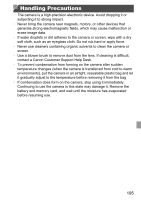Canon PowerShot ELPH 320 HS Blue User Guide - Page 196
On-Screen Information
 |
View all Canon PowerShot ELPH 320 HS Blue manuals
Add to My Manuals
Save this manual to your list of manuals |
Page 196 highlights
On-Screen Information Shooting (Information Display) Shooting mode (p. 200), Scene icon (p. 50) Camera orientation* White balance (p. 102) My Colors (p. 103) Movie recording (p. 94) Drive mode (p. 104) Long Shutter (p. 91), Exposure compensation level (p. 99) Camera shake warning (p. 49) H (Function) (p. 41) Battery level (p. 197) Compression (image quality) (p. 115) / Resolution (pp. 68, 70) ELPH 320 HS IXUS 240 HS Eye-Fi connection status (p. 184) Recordable shots Movie quality AF frame (p. 108) Remaining time Spot AE point frame (p. 100) Focusing range (p. 106), AF lock (p. 113) Digital zoom magnification (p. 53), Digital teleconverter (p. 107) Flash mode (pp. 57, 114) Red-eye correction (p. 68) Touch Shutter (p. 56) Date stamp (p. 58) l (Display) (p. 40) Grid lines (p. 71) Self-timer (p. 54) AE lock (p. 99), FE lock (p. 115) Shutter speed Aperture value Metering method (p. 100) i-Contrast (p. 101) ISO speed (p. 100) Mercury lamp correction (p. 69) Super slow motion movie (shooting time) (p. 94) Zoom bar (p. 47) Blink detection (p. 72) Image stabilization (p. 52) Image stabilization (p. 119) Time zone (p. 156) Wind filter (p. 70) Exposure compensation bar (p. 99) * : Regular orientation, : Held vertically The camera detects the shooting orientation and adjusts settings for optimal shots. Orientation is also detected during playback, and in either orientation, the camera automatically rotates images as needed. However, the orientation may not be detected correctly when the camera is pointed straight up or down. 196















